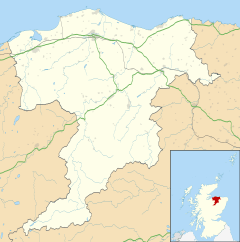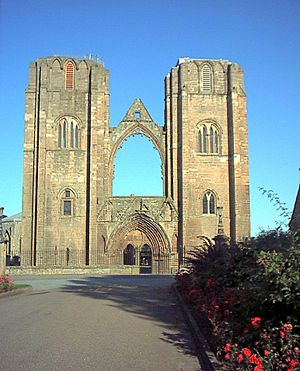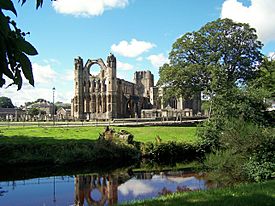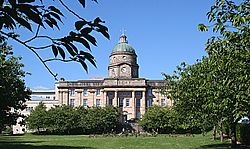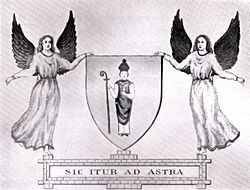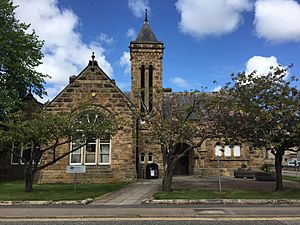Elgin, Moray facts for kids
Quick facts for kids Elgin
|
|
|---|---|
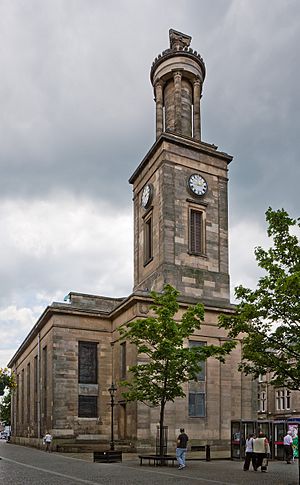 St Giles' Church in Elgin's town centre |
|
| Area | 9.47 km2 (3.66 sq mi) |
| Population | 25,040 (2020) |
| • Density | 2,644/km2 (6,850/sq mi) |
| OS grid reference | NJ220626 |
| • Edinburgh | 117 mi (188 km) |
| • London | 443 mi (713 km) |
| Council area | |
| Lieutenancy area | |
| Country | Scotland |
| Sovereign state | United Kingdom |
| Post town | ELGIN |
| Postcode district | IV30 |
| Dialling code | 01343 |
| Police | Grampian |
| Fire | Grampian |
| Ambulance | Scottish |
| EU Parliament | Scotland |
| UK Parliament |
|
| Scottish Parliament |
|
Elgin is a historic town in Moray, Scotland. It used to be known as a cathedral city and a royal burgh. Today, it's the main administrative and business hub for the Moray area.
The town first grew on higher ground south of the River Lossie. This was away from the river's flood plain. The church of Birnie Kirk was built nearby in 1140. It is still used by the community today.
Elgin was first written about in 1190 AD. King David I of Scotland made it a royal burgh in the 12th century. At that time, a castle stood on top of Lady Hill. The name Elgin likely comes from an old Celtic word. It might mean "beautiful place" or "worthy place." It could also mean "little Ireland."
Contents
History of Elgin
Early Days and Royal Connections
In August 1040, MacBeth's army fought and killed Duncan I of Scotland near Elgin. Elgin is first mentioned in a document from King David I in 1151. He made Elgin a royal burgh around 1130. This happened after he defeated Óengus of Moray.
During King David's time, a castle was built on Lady Hill. Elgin received a special royal charter in 1224. King Alexander II of Scotland gave land for a new cathedral. This cathedral would be the main church for the Bishop of Moray.
Elgin was a favorite place for early Scottish kings. Kings like David I, William I, Alexander II, and Alexander III of Scotland visited often. They held court there and hunted in the royal forests.
Alexander II was especially good to Elgin. He came back to his castle many times. He also set up two religious houses in the town. These were for the Dominicans (Blackfriars) and the Franciscans (Greyfriars). He also founded the Hospital of Maison Dieu. This was a place for poor men and women.
Elgin Cathedral: A Grand Building
On July 19, 1224, the first stone of the new Elgin Cathedral was laid. The cathedral was finished after 1242. But it was completely destroyed by fire in 1270. We don't know why this happened. The ruins you see today are from the rebuilding after that fire. People called the finished cathedral "Mirror of the country and the glory of the kingdom."
Edward I of England visited Elgin twice. In 1296, he was impressed. He wrote that Elgin had a "good castle and good town." By his second visit in 1303, the castle's wooden parts had burned. So, he only stayed for two days.
Later, Robert the Bruce took back Scotland in 1308. He destroyed castles to keep them from the English. The Bishop of Moray, David de Moravia, joined Bruce. They destroyed castles in Inverness, Nairn, and Forres. They also attacked Elgin castle. After two tries, they finally succeeded.
In 1390, a powerful lord named Alexander Stewart, the Wolf of Badenoch, got angry. He burned the town of Forres. In June, he burned much of Elgin too. This included two monasteries, St Giles Church, and the cathedral. Rebuilding the cathedral took many years. But some of the new stone was not as good. So, parts of it crumbled away later. In 1506, the main tower fell. It was rebuilt by 1538.
Changes After the Reformation
After the Scottish Reformation, Elgin's people accepted the new religion. In 1568, the lead was taken from the cathedral roof. This was to be sold to help pay soldiers. But the ship carrying the lead sank. Without the lead roof, the building started to fall apart.
In 1637, parts of the roof blew down. In 1640, local leaders destroyed the beautiful carved screen inside. Between 1650 and 1660, Cromwell's soldiers destroyed the West window. On Easter Sunday 1711, the central tower fell again. This caused even more damage.
People used the fallen stones for other building projects. But in 1807, a man named Joseph King helped. A wall was built around the cathedral. A keeper's house was also put up. A man named John Shanks cleared away huge piles of rubble. This allowed visitors to see the beautiful stonework. He is honored with a large tombstone there.
The cathedral was, and still is, a magnificent building. It was called the Lantern of the North. Bishop Bur described it as "the ornament of this district, the glory of the kingdom."
Prince Charles Edward Stuart visited Elgin in March 1746. He was ill and stayed for 11 days. He stayed at Thunderton House with Mrs Anderson. She was a strong supporter of the Prince. She kept the sheets he slept on and was buried in them. The Duke of Cumberland passed through Elgin on April 13. He was on his way to fight the Prince.
Elgin in the 1800s
In the 1800s, much of old medieval Elgin was changed. The Assembly Rooms were built in 1821. In 1819, Dr Gray's Hospital was built. It has grand columns and a unique dome. Dr Alexander Gray, who made his money with the East India Company, gave £26,000 for the hospital.
In 1828, the new St Giles parish church was built. Lt. General Andrew Anderson, also from the East India Company, gave £70,000 to Elgin. This money was to help the elderly poor and educate orphans. The Anderson Institute was built in 1832. It had space for 50 children and 10 elderly people. Other buildings like the Burgh Court House, museum, and County Buildings were also built.
The Morayshire Railway opened in 1852. It was the first railway north of Aberdeen. It first ran between Elgin and Lossiemouth. The railway and Lossiemouth harbor became very important for Elgin's economy.
By 1882, Elgin was doing well. It had many banks, insurance companies, hotels, and a newspaper. Later, in the 20th century, the villages of Bishopmill and New Elgin became part of the town.
Geography and Climate
Elgin's Location and Landscape
The modern town of Elgin sits on both sides of the River Lossie. The areas of Bishopmill are to the north. New Elgin is to the south.
You can find special rocks around Elgin. These are called Permo-Triassic rocks. They formed when this area was a desert. Quarry Wood, on the edge of town, has a spot called Cuttie's Hillock. Famous fossils called the Elgin Reptiles were found there. There is also a large hill in downtown Elgin. Many tourists like to visit it.
Weather in Elgin
Elgin has a mild, maritime climate. This means it has cool summers and fairly mild winters. This is because it is close to the sea. It doesn't get a lot of rain. This is because it is in the rain shadow of mountains to the west.
| Climate data for Elgin (18m asl, averages 1981-2010) | |||||||||||||
|---|---|---|---|---|---|---|---|---|---|---|---|---|---|
| Month | Jan | Feb | Mar | Apr | May | Jun | Jul | Aug | Sep | Oct | Nov | Dec | Year |
| Mean daily maximum °C (°F) | 6.8 (44.2) |
7.2 (45.0) |
9.1 (48.4) |
11.2 (52.2) |
13.8 (56.8) |
16.1 (61.0) |
18.5 (65.3) |
18.2 (64.8) |
16.0 (60.8) |
12.7 (54.9) |
9.3 (48.7) |
6.7 (44.1) |
12.1 (53.9) |
| Mean daily minimum °C (°F) | 0.4 (32.7) |
0.6 (33.1) |
1.9 (35.4) |
3.6 (38.5) |
5.9 (42.6) |
8.9 (48.0) |
10.8 (51.4) |
10.6 (51.1) |
8.5 (47.3) |
5.7 (42.3) |
2.8 (37.0) |
0.2 (32.4) |
5.0 (41.0) |
| Average rainfall mm (inches) | 54.2 (2.13) |
45.9 (1.81) |
48.2 (1.90) |
40.9 (1.61) |
48.4 (1.91) |
55.7 (2.19) |
58.9 (2.32) |
61.9 (2.44) |
70.1 (2.76) |
73.9 (2.91) |
62.0 (2.44) |
52.6 (2.07) |
672.7 (26.49) |
| Average rainy days (≥ 1 mm) | 11.9 | 9.9 | 11.9 | 9.6 | 9.7 | 10.9 | 10.7 | 11.5 | 11.7 | 13.2 | 12.6 | 11.9 | 135.5 |
Elgin's population in 1901 was 8460.
Economy and Jobs
Local Industries
Many jobs in Elgin and nearby areas depend on Royal Air Force (RAF) bases. In 2005, RAF Lossiemouth and RAF Kinloss brought a lot of money to the Moray economy. They provided about 21% of all jobs in the area. When RAF Kinloss closed, it had a big effect. People fought to save RAF Lossiemouth, and it was saved.
Other important jobs are in local government, construction, and food and drink. Tourism, transport, and business services also provide many jobs.
Whisky making is a big part of the local economy. Distilleries like Glen Moray distillery, Miltonduff distillery, and BenRiach distillery are all close to Elgin.
In 2006, Elgin was found to be one of the most expensive towns in Scotland to buy a house.
Getting Around Elgin
Roads, Trains, and Buses
Elgin is on the A96 road. This road connects Aberdeen and Inverness. There is often a lot of traffic in town. People want a bypass road to help with this. A bypass would remove about one-third of the traffic. The A941 road also runs through Elgin.
Elgin railway station has trains run by ScotRail. You can take trains to Aberdeen and Inverness. From there, you can connect to other places in the UK.
Elgin's bus station is next to the St Giles Centre. Stagecoach runs most of the buses. They offer services within Elgin and to other towns. You can also take buses to Aberdeen and Inverness.
The closest airports are Inverness Airport and Aberdeen Airport. Inverness has flights mostly within the UK. Aberdeen has flights to the UK and other countries.
Learning and Care
Schools in Elgin
Elgin has many schools for different ages:
- Nursery Schools:
* Ark Childcare, Mosstowie * Jack 'n' Jill Pre-School Centre * Moray Leisure Centre Pre-School Nursery * Magic Roundabout Pre-School Nursery * St Sylvesters Nursery * Bishopmill Nursery * Seafield Nursery * Liberty Kids
- Primary Schools:
* Aberlour House * Bishopmill Primary School * East End Primary School * Greenwards Primary School * New Elgin Primary School * Seafield Primary School * West End Primary School * St Sylvester's RC Primary School * Linkwood Primary School
- Secondary Schools:
* Elgin Academy * Elgin High School * Gordonstoun
- Further Education:
* Moray College
Hospitals and Care Homes
- Hospitals:
* Dr Gray's Hospital
- Hospice:
* The Oaks Hospice
Religion in Elgin
Elgin has places of worship for different religions:
* St Giles', High Street * St Columba's South, Moss Street * Elgin High, North Guildry Street
- Free Church of Scotland:
* Free Church, South Street
- Baptist Union of Scotland
- Roman Catholic Church:
* St Sylvester's, Institution Road * Greyfriars Sisters of Mercy Convent in Elgin
- Scottish Episcopal Church
- Other Faiths:
* The Church of Jesus Christ of Latter-day Saints * Jehovah's Witnesses * Calvary Christian Life Centre * True Jesus Church * Pentecostal Church of God * Brethren, Riverside Gospel Hall
Fun Things to Do
Culture and Leisure Activities
Elgin offers many places for culture and fun:
- Elgin Museum
- Elgin Library, in Cooper Park
- Elgin Golf Club
- Cooper Park: You can go boating, play pitch and putt, or tennis.
- Biblical Gardens
- Moray Leisure Centre: It has a swimming pool, ice rink, and gym.
- Moray Sports Centre
- Elgin Town Hall: A place for shows.
- Community Centre: For activities like badminton.
- The Lantern Gallery
- Red Shoes Theatre and music venue
- Elgin Youth Café
- Moray Jazz Club
- Dandy Lion statue, at the Plainstones
Media and Music Scene
You can get TV signals from the Knockmore transmitter.
Radio stations include BBC Radio Scotland, BBC Radio Nan Gaidheal (for Gaelic speakers), and MFR. Wave Radio is a local station from Dr Gray's Hospital.
The local newspaper is Northern Scot.
In the 1960s, famous bands played in Elgin. The Beatles, The Who, Pink Floyd, Cream, and Dusty Springfield performed at the Two Red Shoes dancehall. The Kinks played at Elgin Town Hall.
Sports in Elgin
Football, Rugby, and More
In August 2021, a new community sports facility opened. It has a full-size football pitch and two smaller ones.
- Football:
* Elgin City is the town's main football club. They play at Borough Briggs stadium. They joined the Scottish Football League in 2000. Famous players like Andy Goram and Jimmy Johnstone have played for them. * Two junior teams are Bishopmill United and New Elgin. * Other local teams include Moray Social, Golden Pheasant F.C., and Bishopmill Villa.
- Rugby Union:
* Moray RFC was started in 1923. They play their home games at Morriston Playing Fields.
- Cricket:
* Elgin Cricket Club plays home games at Cooper Park.
- Ice Hockey:
* Elgin is home to the Moray Typhoons. They are an SNL team. They play at the Moray Leisure Centre.
- Roller Derby:
* The Helgin roller derby team practices regularly in Elgin.
Twin Town
Elgin has been twinned with Landshut in Bavaria, Germany, since 1956.
Famous People from Elgin
Notable Individuals
Many interesting people have come from Elgin:
- William Wiseman (1295–1309), a nobleman and Sheriff of Elgin.
- Alexander Brodie Spark (1792–1856), a banker and merchant.
- Lt William Rennie (1822–1887), who received the Victoria Cross.
- Mary Ann Maitland (1839–1919), an author.
- Sir David Hardie (1856–1945), an Australian doctor.
- John Grant (1876–1961), a bagpipe musician.
- Margaret Hasluck (1885–1947), an author and expert on cultures.
- James Low (1894–1960), a footballer.
- Masataka Taketsuru (1894–1979), a Japanese whisky maker.
- Frederick Fyvie Bruce (1910–1990), a theologian.
- Archbishop Mario Conti (born 1934), a former Archbishop of Glasgow.
- Leslie Benzies (born 1971), a video game designer.
- Kevin McKidd (born 1973), an actor and director.
- Steven Pressley (born 1973), a former international footballer.
- Lesley Souter (1917–1981), the first female electrical engineer from the University of Glasgow.
- Chris Clark (born 1980), a footballer.
- Richard Foster (born 1985), a footballer.
|
See also
 In Spanish: Elgin para niños
In Spanish: Elgin para niños


